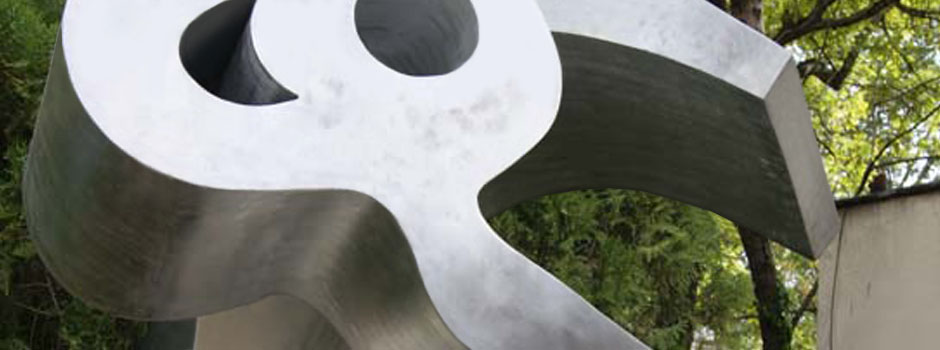
Meem Gallery Exhibited Two Important Works by Parviz Tanavoli & Dia Al-Azzawi at Abu Dhabi Art
Nov 21, 2011 Exhibition

Parviz Tanavoli (b. 1937, Tehran) is one of Iran’s foremost artists, considered as the country’s first significant modern sculptor. A central figure in the formation of the Saqqakhaneh School—a neotraditional style of art that derives inspiration from Iranian folk art and culture - Tanavoli has created works in bronze, ceramic, fiberglass and scrap metal.
 Parviz Tanavoli / Big Heech, 1973, Aluminum unique, 300x205x180 cm. Courtesy of Meem Gallery
Parviz Tanavoli / Big Heech, 1973, Aluminum unique, 300x205x180 cm. Courtesy of Meem Gallery
His oeuvre displays a deep engagement with Persian folkloric traditions, poetry and literature, all expressed in a recurring series of subjects, including the calligraphic figure of Heech (Nothingness), Farhad the Mountain Carver, Lock, Poet, Prophet, Lovers, Walls, Hand, Lion and Bird. He is also a painter and created a series of gabbehs during the early 1980s. Additionally, Tanavoli is a prolific writer. He has authored numerous books and articles on the artistic culture of Iran, featuring in publications such as Hali, Tavoos and Oriental Rug Review.
He has held solo exhibitions in Iran, Europe, United States and Canada and participated in numerous biennales and group exhibitions including, Contemporary Art from the Islamic World, Barbican Centre, London, 1989; Continental Shift, Museums of Aachen, Maastricht, Heerlen and Liège, 2000; Picturing Iran: Art, Society and Revolution, Grey Art Gallery, New York, 2002; and Word into Art, British Museum, London, 2006. His works are housed in international private and public collections, including the British Museum, London; Grey Art Gallery, New York University Collection; Hamline University, St.Paul, Minnesota; Esfahan City Center; Museum of Modern Art, New York; Nelson Rockefeller Collection, New York; Museum of Modern Art, Vienna; Olympic Park, Seoul; DIFC, Dubai; and Royal Society of Fine Arts, Amman.
In 1979, Tanavoli retired as head of the sculpture department at Tehran University and left Iran with his family to settle in Vancouver. During this time, he published extensively on the crafts traditions of Iran, travelling to the country regularly for research and continuing to exhibit his works and collections internationally.
Dia Al-Azzawi (b. 1939), is internationally recognised as one of the pioneers of modern Arab art. His oeuvre comprises over forty years of work and displays the remarkable creativity of an incredibly versatile artist. Defined by its powerful visual impact and brilliant colour, Al-Azzawi’s art covers a range of subjects executed in a variety of media—including painting, sculpture, prints, drawings, and book art. He lives and works in London but continues to derive inspiration from his homeland, Iraq.
 Dia Azzawi / Elegy to my trapped home, 2011, Acrylic on canvas, 240x800 cm. Courtesy of Meem Gallery.
Dia Azzawi / Elegy to my trapped home, 2011, Acrylic on canvas, 240x800 cm. Courtesy of Meem Gallery.
Al-Azzawi started his artistic career in 1964, after graduating from the Institute of Fine Arts in Baghdad and completing a degree in Archaeology from Baghdad University in 1962. His studies of ancient civilizations and Iraqi heritage had a profound impact on his art, and a key objective in the early formation of his artistic style was to link the visual culture of the past to the present. With exhibitions of his work held worldwide, his art features in the collections of museums and institutions including the Museum of Modern Art, Baghdad; Arab Museum of Modern Art, Qatar Foundation, Doha; Museum of Modern Art, Damascus; Museum of Modern Art, Tunis; Museum of Modern Art, Amman; Kinda Foundation, Saudi Arabia; Una Foundation, Casablanca; Arab Monetary Fund, Abu Dhabi; Development Fund, Kuwait; Jeddah International Airport; British Museum, London; Victoria and Albert Museum, London; Saudi Bank, London; United Bank of Kuwait, London; Institut du Monde Arabe, Paris; Bibliothèque Nationale de France, Paris; Colas Foundation, Paris; Harba Collection, Iraq and Italy; Gulbenkian Collection, Barcelona; Library of Congress, Washington D.C.; and The World Bank, Washington D.C.
Arabic script, literature and poetry have also featured in Al-Azzawi’s work. However, he did not use text as the central motif of his images as he considered it to be, ‘part of the group of elements of which the painting is composed.’ Similarly, his incorporation of literature and poetry does not result in a visual narrative of the text, but simply alludes to its literary content, which acts as the initial source of inspiration. More recently, Al-Azzawi stopped using Arabic script altogether, stating that he ‘found that this kind of work became less challenging, and lately we can notice how it has become part of market demand rather than the source of creative and inspiring work.’
Al-Azzawi’s move to London, in 1976, led him to rediscover book art. Having researched the collection of Islamic manuscripts housed in the British Library, he affirms that the art of the book is the truest art form of the Arab world, even more so than painting, and encourages artists of the region to draw inspiration from, and reinterpret, this tradition.
Comments
Add a comment
Commenting is not available in this section entry.